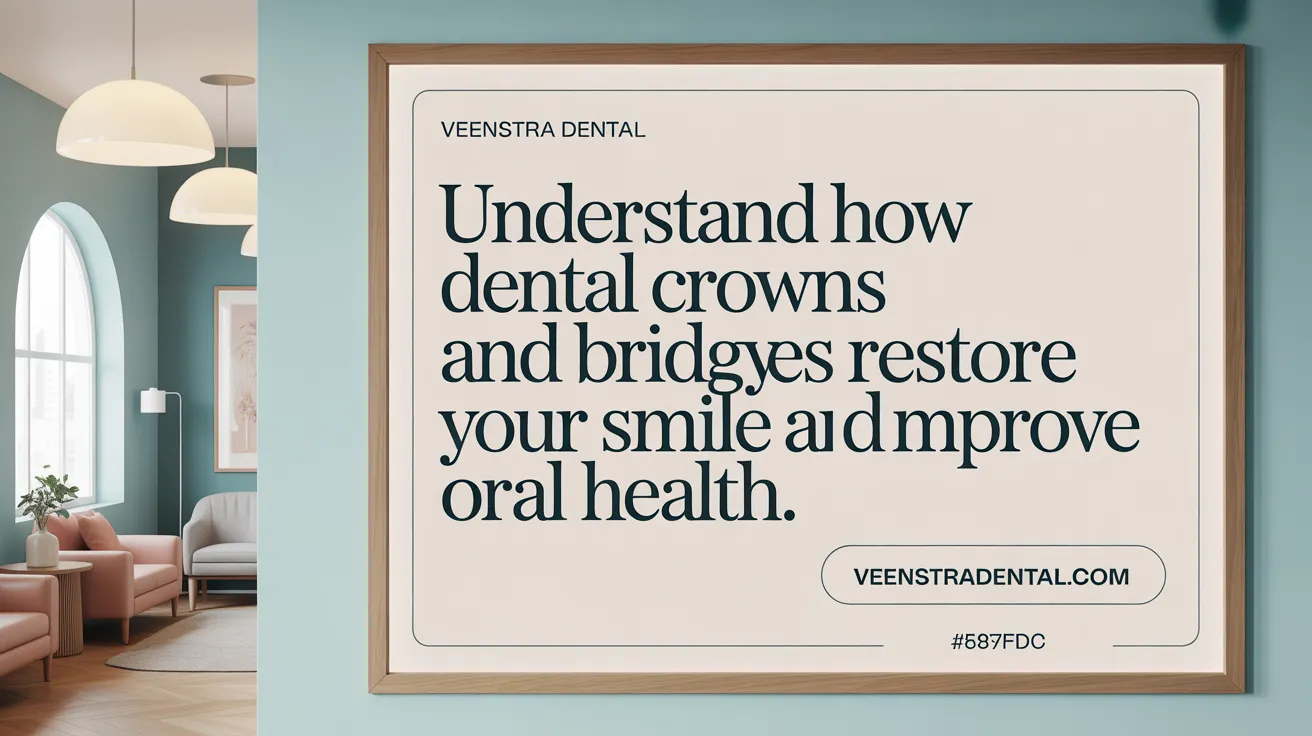Understanding the Foundation of Dental Restorations
Dental crowns and bridges are essential tools in modern dentistry, designed to restore damaged teeth and replace missing ones. These restorations not only repair and protect teeth but also enhance appearance, functionality, and long-term oral health. This article explores the purpose, benefits, materials, procedures, craftsmanship, and care involved in crowns and bridges, shedding light on their vital role in rebuilding broken smiles.
The Purpose and Benefits of Dental Crowns and Bridges

What are dental crowns and bridges, and what benefits do they offer?
Dental crowns and bridges are popular restorative dental treatments designed to repair and replace teeth, helping patients regain their oral health and aesthetic appeal. A dental crown is a custom-made, tooth-shaped cap that covers damaged, decayed, or weakened teeth to restore their original shape, size, strength, and appearance.
On the other hand, a dental bridge is used to fill the gap caused by missing teeth. It consists of artificial teeth called pontics, which are anchored in place by crowns fitted on neighboring natural teeth or dental implants. Bridges not only restore the look of a complete smile but also prevent remaining teeth from shifting out of position.
Both crowns and bridges are crafted from durable materials such as porcelain, ceramic, or metal alloys. They are designed to blend seamlessly with natural teeth, offering a natural appearance and long-term functionality.
The main benefits include improved chewing and speaking abilities, enhanced aesthetic appearance, and preventing further dental issues like decay or misalignment. With proper care, these restorations can last anywhere from five to fifteen years, making them a cost-effective, long-lasting solution.
How do crowns and bridges improve dental function and aesthetics?
Crowns restore the function of teeth that have suffered extensive damage, allowing individuals to eat and speak comfortably. They also protect weakened teeth from further decay or fracture. Bridges fill crucial gaps, maintaining proper bite alignment and preventing neighboring teeth from drifting.
In terms of appearance, crowns and bridges are made to mimic natural teeth closely. Modern materials like high-quality ceramics and zirconia provide a natural look in color and texture, boosting confidence and overall facial aesthetics.
What is their role in maintaining overall oral health?
Both crowns and bridges contribute significantly to oral health. Crowns protect compromised teeth from further decay and damage, especially after root canal procedures or large fillings. Bridges prevent the shifting of teeth, which can lead to bite problems, gum disease, and difficulty in cleaning.
Regular dental visits, combined with good hygiene practices like brushing and flossing, help prolong the lifespan of these restorations. Clinicians may also perform professional cleaning under bridges to prevent plaque buildup.
How durable and long-lasting are crowns and bridges?
Durability varies based on materials used and patient care. Crowns and bridges typically last between 5 and 15 years, with high-quality options like zirconia offering up to 20 years of functional life.
Maintaining good oral hygiene, avoiding sticky or hard foods, and attending routine dental checkups can extend their longevity. In some cases, advancements in dental materials and techniques continue to improve the lifespan of these restorations.
| Aspect | Details | Additional Info |
|---|---|---|
| Materials | Porcelain, ceramic, metal alloys | Affects appearance, durability, cost |
| Longevity | 5-15 years, up to 20 with premium materials | Depends on oral hygiene, habits |
| Care Tips | Regular brushing, flossing, checkups | Prevents decay, preserves restoration |
| Benefits | Restores function, appearance, prevents shifting | Increases confidence and health |
Crowns and bridges are essential tools in modern dentistry, offering durable, natural-looking, and functional solutions that restore both the beauty and health of your smile.
Materials and Types of Crowns and Bridges: Balancing Strength and Aesthetics

What types and materials are used for dental crowns and bridges?
Dental crowns and bridges are crafted from a range of materials designed to provide both strength and a natural look. The most common materials for crowns include porcelain, ceramic, zirconia, and composite resins. These materials are chosen for their ability to closely mimic the appearance of natural teeth, making them an excellent choice for front-facing restorations.
Metal options, such as gold, palladium, nickel alloys, and stainless steel, are favored for their exceptional durability and strength, often used for molars and areas where biting forces are high. Porcelain fused to metal (PFM) crowns combine the natural look of porcelain with the strength of metal, offering a balanced option suitable for many situations.
When it comes to bridges, materials can include porcelain, ceramics, zirconium, and metal alloys. Some bridges feature reinforcement with metal to enhance their longevity and stability, especially in areas subject to heavy chewing.
Aesthetic and functional considerations
Choosing the right material depends on multiple factors, including where the restoration will be placed and the specific needs of the patient. For visible front teeth, porcelain and ceramic are often preferred due to their natural appearance.
Durability is vital for molars or in patients with bruxism (teeth grinding), where metal alloys or zirconia might be more appropriate. The choice also considers factors like allergies—many metals can cause sensitivities, so biocompatibility is considered.
Options based on location and patient needs
| Material Type | Typical Use | Advantages | Disadvantages |
|---|---|---|---|
| Porcelain | Front teeth | Excellent appearance, matches natural teeth | Less resistant to fracture |
| Ceramic | Front and back teeth | High aesthetics, durable | Slightly less durable than metals |
| Zirconia | All regions, especially molars | Very strong, good aesthetics | More expensive |
| Metal alloys (gold, nickel) | Molars, high-stress areas | Extremely durable, long-lasting | Less natural appearance |
| Porcelain-fused-to-metal | Versatile, functional areas | Combines strength and aesthetics | Can show metal margins if gums recede |
Choosing the appropriate material involves balancing aesthetics, strength, patient allergies, location in the mouth, and budget. Modern advancements continue to improve the realism and durability of all options, ensuring patients receive restorations fit for their needs.
Step-by-Step Procedure for Placing Crowns and Bridges

What is the procedure for placing dental crowns and bridges?
The process of installing crowns and bridges is a detailed procedure that ensures a proper fit, durability, and natural appearance. It starts with an initial consultation where the dentist assesses the condition of the teeth through clinical examinations, X-rays, and impressions or digital scans.
For dental crowns, the affected tooth must be reshaped by removing a small amount of enamel, creating space for the crown to fit snugly over the tooth. Precise impressions or digital scans are then taken to help craft a custom crown in a dental laboratory. Traditional methods might involve taking physical molds, but digital impressions are becoming more common for higher accuracy.
In the case of dental bridges, the adjacent healthy teeth—known as abutments—also need preparation. This involves reshaping these teeth, often with local anesthesia, to support the pontic (the false tooth in the bridge). Similar to crowns, impressions or digital scans are used to design the bridge, ensuring it matches the size, shape, and color of surrounding teeth.
Once the lab completes the crown or bridge—generally within about two weeks—the patient returns for placement. During this appointment, the temporary restoration (if used) is removed. The dentist then fits the permanent crown or bridge, making any adjustments needed to ensure a comfortable bite and aesthetic integration.
The final step involves cementing or bonding the restoration securely. After placement, professional care includes maintaining excellent oral hygiene, avoiding very hard or sticky foods, and scheduling regular dental check-ups. Proper care helps maximize the lifespan of crowns and bridges, often allowing them to serve patients for many years.
This comprehensive process guarantees that the restorations not only restore function and appearance but also uphold the health of the remaining natural teeth and gums.
Craftsmanship Behind the Scenes: The Art and Science of Crowns and Bridges

What craftsmanship and techniques are involved in creating dental crowns and bridges?
Creating dental crowns and bridges is both an art and a science, requiring skilled craftsmanship combined with advanced technological methods. The process begins with the careful selection of high-quality materials such as porcelain, zirconia, or metal alloys. Skilled dental technicians then layer these materials meticulously to mimic the natural color, translucency, and surface texture of real teeth.
Modern fabrication techniques have revolutionized this process. Digital impressions captured by intraoral scanners feed into CAD (Computer-Aided Design) systems that allow precise modeling of the restoration. Using CAD/CAM (Computer-Aided Manufacturing) technology, restorations are designed with exact specifications and then milled with high precision using CNC (Computer Numerical Control) machines. In some cases, 3D printing is employed to create accurate prototypes or even the final product.
Traditional methods still play a vital role in producing highly aesthetic results. Techniques like wax-up modeling, where wax patterns are formed manually, and press fabrication, which involves pressing ceramic materials into molds, contribute to detailed surface features and natural appearance. Surface detailing such as slight color gradations, fine pigmentation, and surface texture are carefully applied to achieve an indistinguishable match with natural teeth.
This craftsmanship ensures the final restorations balance visual appeal with functional correctness. Restorations are designed to restore natural tooth contours, maintain proper bite alignment (occlusion), and seamlessly blend into the patient’s existing smile. The combined use of manual artistry and cutting-edge technology results in crowns and bridges that are durable, comfortable, and virtually indistinguishable from natural teeth, providing both aesthetic satisfaction and reliable strength.
| Technique / Material | Purpose / Advantage | Artistic/Technological Element |
|---|---|---|
| Porcelain layering | Mimics natural translucency | Manual application and shading |
| Zirconia framework | Strong, durable base | Computer-aided design to optimize fit |
| CAD/CAM milling | Precise fit and uniformity | Digital design and automated milling |
| 3D printing | Custom prototypes and models | Additive manufacturing technology |
| Surface detailing | Enhances natural look | Hand-painted pigmentation and texturing |
This integration of art and technology ensures that each crown and bridge not only restores function but also enhances the aesthetics, leading to a more confident smile for the patient.
Maintaining Your Crowns and Bridges for Lasting Smile Success
 Taking good care of dental crowns and bridges is essential for their longevity and your overall oral health. Daily oral hygiene practices are the foundation; brush your teeth twice a day with a soft-bristled toothbrush and fluoride toothpaste. Flossing daily is equally important, and tools like floss threaders or water flossers can help remove plaque around these restorations.
Taking good care of dental crowns and bridges is essential for their longevity and your overall oral health. Daily oral hygiene practices are the foundation; brush your teeth twice a day with a soft-bristled toothbrush and fluoride toothpaste. Flossing daily is equally important, and tools like floss threaders or water flossers can help remove plaque around these restorations.
Dietary choices also play a role in protecting your dental work. Avoid biting or chewing hard, sticky, or chewy foods such as ice, caramel, or nuts, which can cause damage or dislodge crowns and bridges. Being mindful of what you eat can go a long way in maintaining your restoration's integrity.
Regular dental visits are crucial. Professional cleanings and check-ups allow your dentist to assess the condition of your crowns and bridges, catch early signs of wear or issues, and prevent more serious problems from developing. Your dentist can also remove plaque or tartar buildup that could compromise your restorations.
Managing potential complications involves using mouthguards during sports or nighttime if you grind your teeth. These protective devices help prevent wear, chips, or fractures. Avoid tobacco products, as they can stain your restorations and increase the risk of gum disease around the supporting teeth.
If you experience any discomfort, sensitivity, or notice damage, contact your dentist promptly. Never attempt DIY repairs on your crowns or bridges—professional intervention is necessary to ensure proper restoration and health.
By following these guidelines, you can enjoy the benefits of your crowns and bridges for many years, maintaining a healthy, beautiful smile.
Rebuilding Smiles with Precision and Care
Dental crowns and bridges stand as remarkable examples of how science, art, and skilled craftsmanship align to restore broken smiles. These custom restorations not only repair dental damage and replace missing teeth but also rejuvenate function, aesthetics, and confidence. With careful selection of materials, meticulous placement procedures, and diligent maintenance, crowns and bridges provide durable, natural-looking solutions that transform lives. Embracing these dental restorations empowers individuals to enjoy improved oral health, enhanced quality of life, and the joy of a fully restored smile.
References
- Exploring the Art of Dental Crowns and Bridges
- Restoring Smiles: Exploring the Art of Dental Crowns and ...
- Crowns & Bridges Johnston IA
- High-Quality Dental Crowns & Bridges Lilburn, GA
- Understanding Crowns and Bridges: Restoring Your Smile
- Dental Crowns and Bridges: Restoring Your Smile's ...
- Dental Crowns & Bridges | The Art of Dentistry
- Crowns and Bridges | Restoring Smiles at RGC Dentistry
- Crowns and Bridges Tampa FL
